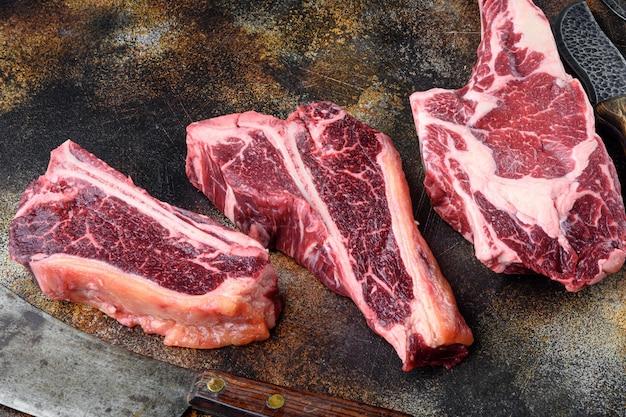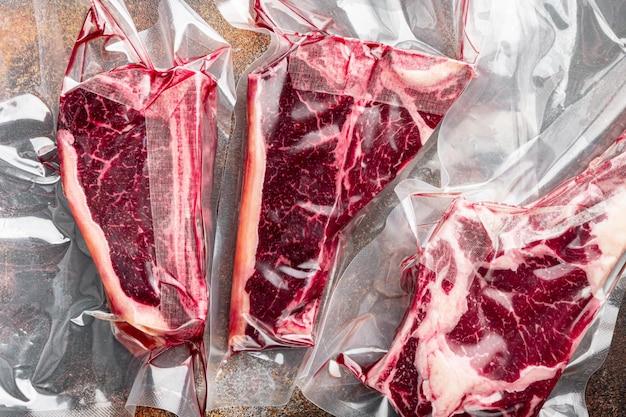Dry aged beef is a treat for meat lovers. But what happens when you’ve got a beautiful piece of dry-aged beef sitting in your fridge and you’re not sure if it’s still good to eat? Don’t worry, we’ve got you covered! In this blog post, we will explore the signs that indicate whether your dry aged beef has gone bad or is still safe to consume.
From the texture and color of the meat to the smell it emits, we will uncover the key indicators that can help you determine if your dry aged beef has passed its prime. We will also address common concerns such as the presence of mold, the risks of consuming spoiled meat, and the time limit for storing dry aged beef in the fridge. So, grab a seat and let’s dive into the world of dry aged beef!
How to Determine if Dry Aged Beef is Past its Prime
Understanding the Telltale Signs of Spoilage
Dry-aged beef is a culinary delight, offering rich flavors and a tender texture that cannot be replicated. But just like any other perishable food, there comes a time when it goes past its prime. To ensure you’re savoring the best possible experience, it’s important to recognize the telltale signs of when dry-aged beef has gone bad. Keep on reading to become a beef connoisseur!
Check the Color
One of the first signs to look out for is the color of the beef. Fresh dry-aged beef should have a deep, dark red color with a slightly brown exterior. However, if you notice the meat turning an off-putting shade of green or gray, it’s a surefire indicator that it has bid adieu to its prime. But don’t panic just yet; it’s normal for the edges of the meat to go slightly brown due to the drying process.
Trust Your Nose
Ah, the distinctive aroma of dry-aged beef! When beef ages, it develops an earthy, nutty scent that makes your mouth water. However, if your nostrils are assaulted by a pungent smell that resembles spoiled milk or rotten eggs, it’s a clear sign that the beef has overstayed its welcome. In such cases, it’s better to play it safe and not take any chances with your taste buds or your gastrointestinal system.
Examine the Texture
Dry-aged beef should have a beautifully marbled appearance with a velvety, smooth texture. As you run your fingers across the surface, the meat should feel firm and slightly moist. However, if you notice a slimy or tacky texture, it’s time to wave goodbye to that cut of beef. A slimy texture usually indicates the growth of harmful bacteria, and trust me, you don’t want to mess with bacteria.
Mold Matters
While a touch of mold can be normal in the aging process, too much of it is a red flag. If you spot an excessive amount of mold, with patches covering a significant portion of the meat, it’s time to part ways. Mold can release toxins that are harmful to your health, so it’s best not to take any chances, no matter how adventurous you consider your palate to be.
Let Your Taste Buds Be the Judge
Now, the moment you’ve been waiting for—the taste test! Take a small bite of your dry-aged beef and allow your taste buds to dance with delight. If the flavor is rich, intense, and lingers on your palate, you’re indulging in greatness. However, if you detect any rancidity, bitterness, or an unpleasant sourness, it’s a sure sign that the party’s over. Spit it out, my friend. Remember, dry-aged beef should taste heavenly, not like a nightmare.
Adios, Bad Beef!
In conclusion, understanding the signs of spoiled dry-aged beef is essential to ensure you savor only the best. From checking the color, trusting your nose, examining the texture, watching out for mold, to finally relying on your taste buds, each step contributes to an informed decision. So, my fellow beef enthusiasts, arm yourselves with this knowledge and bid farewell to any beef that has passed its prime. Your taste buds will thank you for it!
Note: The terms ‘gone bad’, ‘past its prime’, and ‘spoiled’ have been used interchangeably throughout this section.
FAQ: How To Tell If Dry Aged Beef Has Gone Bad
Welcome to our FAQ-style guide on how to determine if dry-aged beef has gone bad. Dry-aged beef is a delicacy renowned for its rich, intense flavors and tender texture. However, as with any perishable food, it is important to be able to identify signs of spoilage. In this comprehensive guide, we’ll answer frequently asked questions about determining the quality and freshness of dry-aged beef. So, put on your detective hat, and let’s delve into the realm of beef investigation!
How can you tell if meat is spoiled
When it comes to assessing meat, the nose knows best! Spoiled meat often emits a pungent, unpleasant odor that is hard to miss. Additionally, the texture of spoiled meat may become slimy or sticky, and the color can change to a dull gray or brown. If in doubt, it’s always better to err on the side of caution and discard meat that appears or smells off.
Can dry-aged beef go bad
Dry-aged beef, like any other meat, can go bad if not stored properly or if it exceeds its shelf life. While dry aging helps enhance flavor and tenderness, it does not make the meat impervious to spoilage. However, correctly aged and stored dry-aged beef typically has a longer shelf life compared to regular beef, as the drying process removes moisture and inhibits bacterial growth.
How long does dry-aged beef last in the fridge
Properly stored dry-aged beef can last anywhere from 28 to 45 days in the refrigerator. A controlled temperature of around 34°F to 38°F (-1°C to 3°C) is crucial to maintaining the quality and safety of the meat. Remember, the aging process has already tenderized and intensified the flavors, so don’t hesitate to savor it within that timeframe for the best experience.
What does dry-aged beef smell like
Ah, the delightful scent of dry-aged beef! It is often described as rich, nutty, and reminiscent of buttered popcorn or a good quality Parmesan cheese. The aroma of properly aged beef is a telltale sign of the delicious eating experience that awaits you.
Does wet-aged steak smell
Wet-aged steak typically does not have a strong odor. The aging process of wet-aged steak occurs in vacuum-sealed packaging where the meat is allowed to tenderize in its own juices. While the flavor and texture may improve, the lack of exposure to air during wet aging prevents the development of significant aromas.
Can dry-aged beef make you sick
Dry-aged beef, if stored and prepared correctly, is generally safe to consume. However, it’s important to be mindful of any unusual smells or signs of spoilage. If you have any doubts about the quality or safety of the meat, it’s better to be safe than sorry and avoid consumption.
Does dry-aged steak have mold
Fear not! Contrary to what you might think, the presence of mold on dry-aged beef is not necessarily a cause for concern. Small patches of mold can develop on the surface and are typically carefully trimmed away before cooking. The controlled aging process of dry-aged beef prevents the growth of harmful molds, ensuring the meat remains safe for consumption.
How long is grocery store beef aged
The aging process for grocery store beef can vary depending on the supplier and the specific cut of meat. Typically, grocery store beef undergoes wet aging, which is a faster process that ranges from a few days to three weeks. However, it’s essential to remember that not all grocery store beef is dry-aged, so be sure to check the labeling if you’re specifically looking for dry-aged cuts.
What does bad beef smell like
Bad beef has a distinct, unpleasant odor that is difficult to ignore. It can smell rotten, sulfurous, or even like ammonia. If you encounter a putrid or foul odor emanating from your beef, it’s best to discard it immediately. Your nose will thank you!
What does it mean when raw meat turns grey
If raw meat turns gray, it’s a clear indication that it has started to spoil. The discoloration is caused by the growth of bacteria, and it’s a sign that the meat is no longer fresh and should not be consumed. Remember, when it comes to meat, vibrant red is what you want to see, not shades of gray!
Does aged beef taste rotten
No, aged beef should not taste rotten. On the contrary, properly aged beef has a concentrated, complex flavor that is highly sought after by culinary enthusiasts. The aging process allows natural enzymes to break down the connective tissues, resulting in enhanced tenderness and intensified taste. So, rest assured, aged beef is a delicious delight!
How can you tell if dry-aged beef is bad
To determine if dry-aged beef is bad, rely on your senses. Trust your nose for any off odors, check for a slimy or sticky texture, and examine the color for any significant deviations from the usual deep red. If you notice any of these red flags, your beef may have gone bad, and it’s best to discard it to avoid any potential health risks.
Why does my steak smell sour
A sour smell emanating from your steak may point to the presence of unwanted bacteria. If your steak exhibits this odor, it’s a clear indication that it has spoiled and should not be consumed. Remember, bad smells are a red flag to keep your taste buds safe and sound!
Why does my beef smell like cheese
If your beef has a cheese-like aroma, fear not, for it might not be a cause for concern. Some cuts of dry-aged beef can develop a cheese-like scent due to the aging process. However, if the smell is overly pungent or accompanied by other signs of spoilage, it’s best to exercise caution and seek fresher meat options.
Does dry-aged beef have an odor
Yes, dry-aged beef does have a distinctive, pleasant odor. The unique smell arises from the aging process, which allows complex flavors to develop. Embrace the heavenly aroma as you prepare to indulge in a truly exceptional dining experience.
We hope this FAQ-style guide has shed light on the various factors to consider when determining if dry-aged beef has gone bad. Remember, trusting your senses is key, and when in doubt, it’s always better to be safe than sorry. By being vigilant and attentive, you can ensure that your dry-aged beef experience is nothing short of extraordinary. So, go forth and savor the melt-in-your-mouth deliciousness, confident in your ability to detect the signs of spoiled beef. Happy meat inspection!

